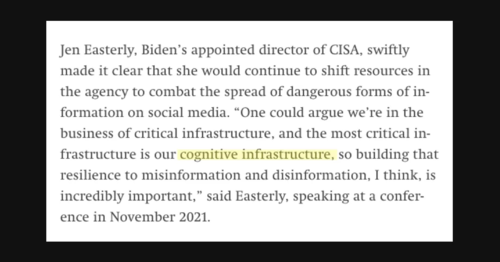Cognitive infrastructure
 | |
What is Cognitive infrastructure (CI)?
Historically, when new infrastructure appeared, it was usually explicitly and commercially important — think of the canal systems, and then the railroads, that knit together the United States, or the birth of electric infrastructure in the early 1900s. These examples may be quite complicated, but they are single, intelligible systems. Cognitive infrastructure, however, is a meta-infrastructure; it involves accelerating capability and capacity across a number of seemingly unrelated systems and technologies, including 5G communications networks, artificial intelligence and big-data analytics programs, social media, internet-connected appliances and devices, media creation and manipulation tools, cloud storage, and more. Moreover, it is institutionally complex; communities and institutions ranging from activist groups to private firms to militaries develop and use elements of cognitive infrastructure.
Managing CI
CI involves a level of complexity and information flow that humans can neither understand nor perceive. People are low-bandwidth cognitive mechanisms in a world where cognitive infrastructure even today operates at far higher bandwidths, much faster speeds, and higher levels of complexity than individuals can hope to access.
Knowing, however, that the emerging cognitive infrastructure involves a conceptually new, more complex system provides a bracing reality check to many of the policy formulations floated by governments and academics. Just as the US government could not regulate Rockefeller’s Standard Oil by using the rules applicable to a local coal supplier, attempts to manage the evolving cognitive infrastructure in the same way governments regulated, say, telecoms, are based on mistaken assumptions and doomed to failure. Among many other issues, for example, the cognitive infrastructure is a complex adaptive global system, so the likelihood that national or local regulation or legislation will have the desired effect is very low.
Beyond reach
It may be premature to consider tantalising questions such as how humans should respond as the technology to physically interface our minds with elements of cognitive infrastructure such as devices or networks is developed — a very real, but very challenging, question. But it is not premature to recognise that this new infrastructure is already emerging, and to try and understand some of the implications.
Without that first step, ethical, rational, and appropriate policy and institutional adaptation will remain beyond reach.[1]
Building resilience to MDM
Under President Joe Biden, the shifting focus on disinformation has continued. In January 2021, CISA replaced the Countering Foreign Influence Task force with the “Misinformation, Disinformation and Malinformation” team, which was created “to promote more flexibility to focus on general MDM.” By now, the scope of the effort had expanded beyond disinformation produced by foreign governments to include domestic versions. The MDM team, according to one CISA official quoted in the IG report, “counters all types of disinformation, to be responsive to current events.”
Jen Easterly, Biden’s appointed director of CISA, swiftly made it clear that she would continue to shift resources in the agency to combat the spread of dangerous forms of information on social media:
- “One could argue we’re in the business of critical infrastructure, and the most critical infrastructure is our cognitive infrastructure, so building that resilience to misinformation and disinformation, I think, is incredibly important,” said Easterly, speaking at a conference in November 2021.[2]